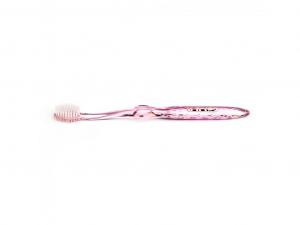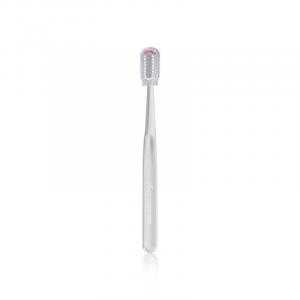
Do you want to have healthy teeth? Learn how to protect yourself from tooth decay

What You Might Not Know About Tooth Decay
Tooth decay is one of the most common health problems worldwide. Although it is often associated with childhood and sweets, it actually affects people of all ages - even those who brush their teeth regularly. You might be wondering: “What does a cavity actually look like?" or “Should I worry about a cavity in a baby tooth if it will fall out anyway?" These are questions many parents and adults ask themselves to ensure they are giving their teeth – even temporary ones – the proper care.
How Tooth Decay Develops and Why It Affects Everyone
Tooth decay results from the action of bacteria that feed on leftover sugars and starches in the mouth. These bacteria produce acids that gradually erode the tooth enamel – the hard outer layer of the tooth. If this process continues, the cavity penetrates deeper into the tooth, reaching the dentin and eventually affecting the nerves and blood vessels inside the tooth.
Interestingly, decay does not occur immediately. It is a slow process that can take months, sometimes years, to reach a painful stage. That's why it's crucial to know how to recognize the first signs of decay and act before the problem worsens.
What a Cavity Looks Like and How to Recognize It
The idea that a cavity is a black hole in the middle of a tooth is only partially true. In reality, it can take many forms and appear differently at various stages. In its early stage, decay manifests as a white or dull spot on the enamel – known as demineralization. At this stage, the process can still be reversed with thorough hygiene and fluoride treatment if caught in time.
If decay continues, a dark spot, yellow-brown or brown-black, may appear, which can feel rough to the touch. In the advanced stage, a real cavity forms – a hole that can be visible to the naked eye. And if the decay affects the front teeth, it is not only painful but also visually noticeable.
Decay on a front tooth is particularly unpleasant – not only does it affect the appearance of the smile, but it is also more sensitive due to the thinner layer of enamel and greater exposure to mechanical stress. Here it is essential to intervene as soon as possible because the damage can be more challenging to repair and often requires a filling or even aesthetic reconstruction.
Decay in Baby Teeth
Many parents tend to underestimate decay in baby teeth. It is often argued: “After all, the teeth will fall out anyway." However, this is a misconception that can have serious consequences. Baby teeth play a crucial role in the development of proper bite, pronunciation, and maintaining space for permanent teeth. If they are damaged or prematurely extracted due to decay, it can lead to orthodontic problems or even infections that affect the developing permanent teeth.
Moreover, decay in a baby tooth spreads faster than in a permanent one – the enamel is thinner and less mineral-resistant. It often happens that within weeks of initial damage, a dentist must perform nerve treatment or extraction. Additionally, the pain associated with decay can significantly stress the child, disrupt sleep, appetite, and negatively affect their relationship with dentistry for life.
A mother from Brno recalls: “My daughter started complaining of toothache, but we didn't see anything. We took her to the dentist after three weeks when the pain worsened – and it turned out she had a deep cavity in her upper incisor. The tooth had to be removed. Today, I would go immediately."
Particularly insidious can be decay on the front baby tooth – it often forms on the back of the incisors, where the child cannot clean well. Especially if they drink sweet drinks from a bottle or often fall asleep with milk in their mouth, the risk dramatically increases.
When to Consult a Professional – and What Not to Do
The basic rule is: if you're not sure whether a tooth is healthy, visiting a dentist won't hurt. Even if the child doesn't report pain, any change in color, spot, or visible damage to the tooth is a reason for examination. Many cavities are painless until they reach the nerve.
For adults, the same applies – decay on the back molars can remain hidden for a long time while already threatening the overall condition of the oral cavity. Decay can spread between teeth or under the gum, where it cannot be detected without an X-ray.
What you definitely shouldn't do is try to "patch" the problem with home methods. On the internet, you will find tips like coconut oil, turmeric, or baking soda – while these substances may have antibacterial effects, they will not stop or reverse the decay. Without professional intervention, it only prolongs the time the problem worsens.
The Old Reliable Basics That Actually Work
You might be surprised that the most important weapons against tooth decay are not miraculous pastes or supermodern toothbrushes. They are three simple habits: regular brushing, reducing sugar, and dental visits. It sounds like a cliché, but these three things make the biggest difference.
For children, it's best to start dental care as soon as the first tooth emerges. Gentle brushes suitable for infants and pastes with a safe amount of fluoride are available today. And yes, parents should brush children's teeth until they are 6–8 years old, as fine motor skills are still developing.
Furthermore, it is crucial to monitor what children eat and drink – sweet drinks, cookies, sweetened cereals, and fruit purees can be full of hidden sugars. And if a child repeatedly suffers from cavities, genetics or saliva composition might be to blame – in that case, consulting an individual prevention plan makes sense.
For adults, interdental hygiene is equally important – dental floss or interdental brushes should be part of the daily routine. Regular dental cleanings also help remove tartar and plaque, which are the main culprits of decay.
Try our natural products
When Decay Occurs
If decay does occur, there are several ways to treat it – they vary depending on the depth and location. In the early stage, decay can be stopped with remineralization using fluoride gels or varnishes. If the decay is more advanced, drilling and filling are necessary. Modern fillings are aesthetic, durable, and often nearly invisible.
For severely damaged teeth, endodontic treatment (root canal treatment), a crown, or extraction may be necessary. For children, doctors try to preserve the baby tooth as long as possible; in some cases, however, removal and subsequent monitoring of the permanent tooth's development is the only option.
In all cases, it holds true: the sooner decay is caught, the less invasive and demanding the treatment is.
Tooth decay may be a common problem, but it is by no means harmless. Whether it's a small cavity on a front tooth or an inconspicuous decay in a baby tooth, early response is key. It's not just about pain or aesthetics – it's about overall health, quality of life, and even self-confidence. Therefore, it makes sense to pay attention to details, teach children proper habits, and not be afraid to ask questions. A healthy smile doesn't start with luck, but with everyday care.





